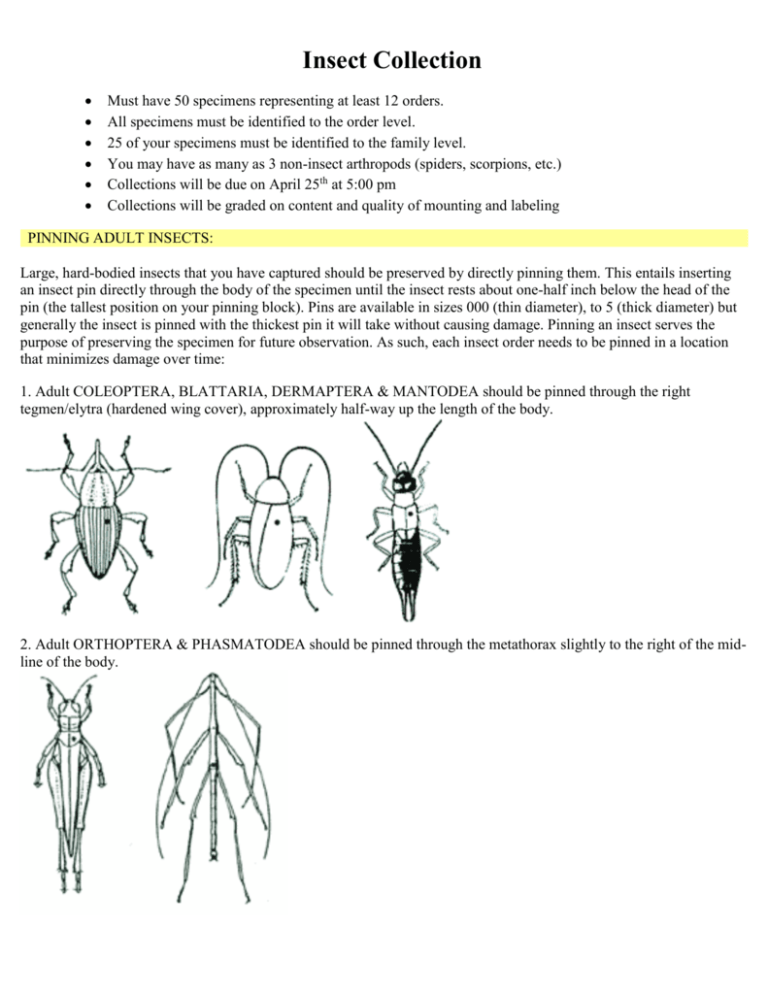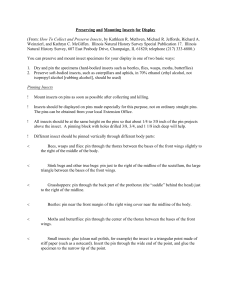Handout 1 - Pinning and labeling
advertisement

Insect Collection Must have 50 specimens representing at least 12 orders. All specimens must be identified to the order level. 25 of your specimens must be identified to the family level. You may have as many as 3 non-insect arthropods (spiders, scorpions, etc.) Collections will be due on April 25th at 5:00 pm Collections will be graded on content and quality of mounting and labeling PINNING ADULT INSECTS: Large, hard-bodied insects that you have captured should be preserved by directly pinning them. This entails inserting an insect pin directly through the body of the specimen until the insect rests about one-half inch below the head of the pin (the tallest position on your pinning block). Pins are available in sizes 000 (thin diameter), to 5 (thick diameter) but generally the insect is pinned with the thickest pin it will take without causing damage. Pinning an insect serves the purpose of preserving the specimen for future observation. As such, each insect order needs to be pinned in a location that minimizes damage over time: 1. Adult COLEOPTERA, BLATTARIA, DERMAPTERA & MANTODEA should be pinned through the right tegmen/elytra (hardened wing cover), approximately half-way up the length of the body. 2. Adult ORTHOPTERA & PHASMATODEA should be pinned through the metathorax slightly to the right of the midline of the body. 3. Adult HEMIPTERA should be pinned through the right corner of the scutellum. 4. Adult DIPTERA, HYMENOPTERA, EPHEMEROPTERA, ODONATA & MECOPTERA should be pinned between the base of the fore-wings, slightly to the right of the mid-line of the body. 5. Adult LEPIDOPTERA should be pinned between the base of the fore-wings, with all four wings spread (the hind margin of the fore-wings and front margin of the hind-wings running at right angles to the length of the body). LABELING PINNED INSECTS: Labeling of pinned insects is required to identify an insect's location and capture date, as well as the type of insect that was captured. This information can be provided on two labels. The first label, which sits closest to the insect (2nd height of your pinning block) should be comprised of 3 lines. The top line provides the PLACE of capture. The middle line provides the DATE of capture (written as day - month - year). The bottom line provides the name of the person that captured the insect. For example: The second label, which sits furthest from the insect (lowest height of your pinning block) should be comprised of two lines. The top line provides the order of the insect on the pin (which you determined using a taxonomic key). The bottom line provides the FAMILY of the insect on the pin (which you determined using a taxonomic key). For example: ALCOHOL PRESERVATION OF SOFT-BODIED INSECTS: Adult MICROCORYPHIA, THYSANURA, TRICHOPTERA, ISOPTERA, PLECOPTERA, NEUROPTERA & GRYLLOBLATTARIA (as well as larvae & nymphs of all orders) are soft-bodied, and should be preserved within a sealed vial of 8090% alcohol. Labels should be similar to those of pinned insects but written in pencil (to prevent dissolution), and inserted directly into the alcohol vial with the insect. POINTING/GLUING SMALL INSECTS: Any adult insect (EXCEPT DIPTERA) that is too small to pin without causing damage should be pointed. Pointing involves inserting an insect pin (usually size 0-1) through the broad end of a small, stout, triangular piece of paper. The small end (tip) of the triangle is bent downward at a right angle (using forceps). A very small amount of glue is placed on this bent tip and this is then applied to the RIGHT side of the insect's thorax. A correctly pointed specimen has its body horizontal to the ground when the pin is upright. Label information and heights should be similar to those of pinned insects however, the pin should be inserted on the right side of the labels so that they are aligned directly beneath the point. Apterygota (wingless insects) 1. Protura (Prot, first; ura, tail) = proturans; ~500 species. 2. Collembola (Coll, glue; embola, a wedge) = springtails; ~4000 species. 3. Diplura (Dipl, two; ura, tail) = two-pronged bristletails; ~500 species. 4. Archaeognatha (Archeo, old; gnath, jaw) = jumping bristletails; ~25 species. 5. Zygentoma = Thysanura (Thysan, fridge; ura, tail) = silverfish; ~400 species. Pterygota (winged insects) I. Hemimetabola (gradual development) “Paleopterous” orders (=primitive winged) orders 6. Odonata (Odon, a tooth) = dragonflies and damselflies; ~5500 species. 7. Ephemeroptera (Ephemero, brief; ptera, wing) = mayflies; ~2500 species. "Orthopteroid" orders (=Polyneoptera) 8. Plecoptera (Pleco, pleat; ptera, wing) = stoneflies; ~1200 species. 9. Embioptera (Embio, lively; ptera, wing) = webspinners, embiids; ~2000 species. 10. Phasmida (Phasm, phantom) = stick insects; ~2000 species. 11. Orthoptera (Ortho, straight; ptera, wing) = grasshoppers, locusts, crickets, katydids;~20,000 species. 12. Dermaptera (Derma, skin; ptera, wing) = earwigs; ~1000 species. 13. Grylloblattodea (Gryll, cricket; blatta, cockroach) = rock crawlers, ice bugs; ~25species. 14. Mantophasmatodea [newest insect order] (Mantid, soothsayer; Phasm, phantom) = ~20 species. 15. Isoptera (Iso, equal; ptera, wing) = termites; ~2000 species. [may belong within the Blattodea] 16. Blattodea (Blatta, cockroach) = cockroaches; ~4200 species. 17. Mantodea (Mantid, soothsayer) = mantids; ~2000 species. 18. Zoraptera (Zor, pure; ptera, wing) = zorapterans; ~25 species. "Hemipteroid" (sucking) orders (=Paraneoptera) 19. Psocoptera (Psoco, rub small; ptera, wing) = booklice, barklice; ~2000 species. 20. Phthiraptera (phthir, lice; a, without; ptera, wing) = lice; ~3000 species. 21. Thysanoptera (Thysano, a fringe; ptera, wing) = thrips; ~400 species. 22. Hemiptera (Hemi, one-half; ptera, wing) = true bugs; ~82,000 species. II. Holometabola (complete development) 23. Coleoptera (Coleo, sheath; ptera, wing) = beetles; ~375,000 species. 24. Neuroptera (Neuro, nerve; ptera, wing) = lacewings and relatives; ~5000 species. 25. Hymenoptera (Hymen, membrane; ptera, wing) = wasps, bees, and ants; ~130,000 species. 26. Trichoptera (Tricho, hair; ptera, wing) = caddisflies; ~7,000 species. 27. Lepidoptera (Lepido, scale; ptera, wing) = butterflies and moths; ~175,000 species. 28. Mecoptera (Meco, long; ptera, wing) = scorpionflies; ~500 species. 29. Siphonaptera (Siphon, a tube; aptera, wingless) = fleas; ~2000 species. 30. Strepsiptera (Strepsi, twisted; ptera, wing) = twisted-winged parasites; ~400 species. 31. Diptera (Di, two; ptera, wing) = true flies; ~125,000 species.






